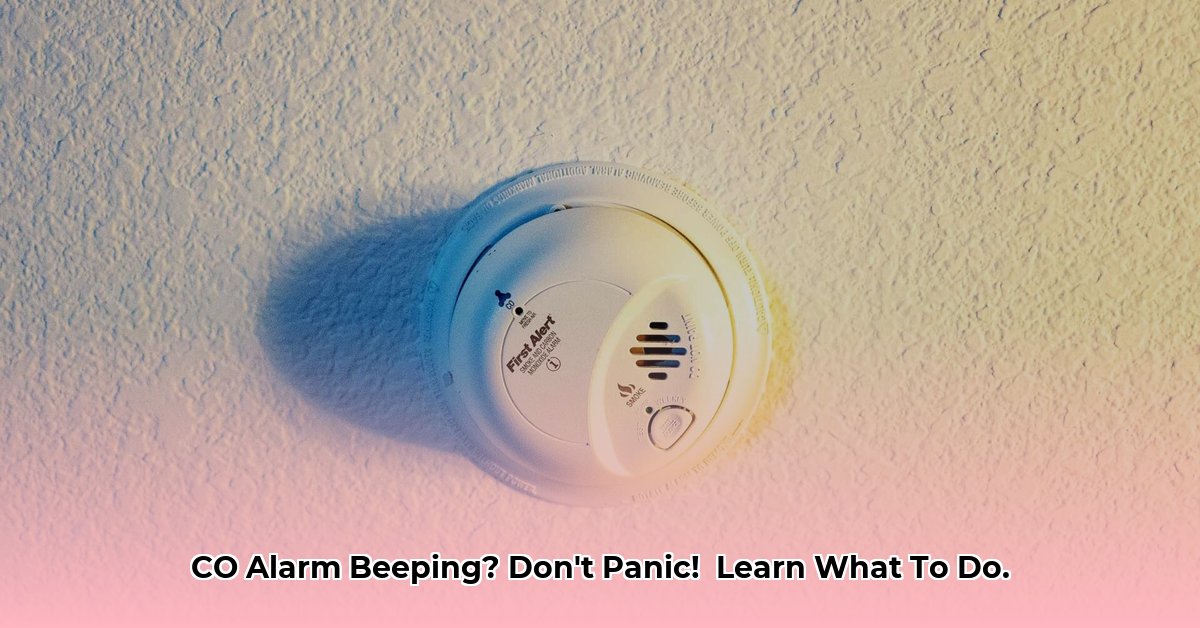Immediate Action: When Your Alarm Sounds
- GET OUT: Evacuate everyone (including pets) immediately.
- CALL 911: From outside the building.
- DO NOT RE-ENTER: Until given the all-clear by emergency services.
Understanding the Beep: Why Your Detector Might Be Going Off
A chirping or beeping carbon monoxide (CO) detector signals a potential problem. It’s crucial to understand these signals and react accordingly.
Decoding the Sounds
- Single Chirp Every 30-60 Seconds: This typically indicates low batteries. Replace them immediately. If the chirping continues with new batteries, the detector itself may need replacing. Some detectors with sealed 10-year lithium batteries will chirp at the end of their lifespan, requiring a full unit replacement.
- Chirping Every 30 Seconds (After 7 Years on Kidde Models): This signifies the detector’s end-of-life. Replace the unit.
- Four Beeps, Then Silence, Repeating: This pattern signals a dangerous level of CO. Evacuate immediately and call 911.
- Continuous or Random Chirping: This could suggest dust buildup, a malfunction, or even high humidity. Try cleaning the detector. If the problem persists, consult the manual or contact the manufacturer.
- One Long, Continuous Squeal: This often indicates a tamper-resist issue or a malfunction. Check connections and consult the manual or manufacturer if the squealing continues.
- Three Beeps (Some Models): This signal’s meaning varies depending on the model. It could indicate low battery, end-of-life, or another error. Check your manual.
- Error Code (Digital Displays): Some detectors display error codes. Refer to your manual to decipher the code’s meaning.
Other Potential Triggers
- Dust and Debris: Accumulated dust can interfere with the sensor. Regularly vacuum the detector’s exterior vents.
- Chemical Fumes: Fumes from household products, paints, or solvents might temporarily trigger the alarm. Ventilate the area well.
- Extreme Temperatures: Extreme temperatures can sometimes affect detector sensitivity. Avoid placing detectors near heat sources or in excessively cold locations.
- Malfunctioning Appliances: Furnaces and other fuel-burning appliances that aren’t operating correctly can release CO. A yellow or orange flame (instead of blue) on a gas appliance suggests incomplete combustion and requires immediate professional attention.
Troubleshooting Your CO Alarm: A Step-by-Step Guide
- Check the Battery: Replace the batteries.
- Clean the Detector: Gently vacuum dust and debris from the vents.
- Relocate the Detector: If humidity is a suspect, move the detector to a better-ventilated area away from drafts and obstructions.
- Inspect Fuel-Burning Appliances: Ensure proper function and check for a blue flame (in gas appliances). Consider consulting a professional for a furnace inspection.
- Test the Alarm: Press the test button. No alarm? Replace the detector.
- Replace the Detector: If troubleshooting fails, replace the entire unit, especially if it’s nearing its expiration date (typically 5-7 years).
CO Detector Placement: Maximizing Protection
- Every Level: Install detectors on every level of your home, including the basement.
- Near Sleeping Areas: Place detectors outside each sleeping area.
- 15-20 Feet from Fuel-Burning Appliances: Avoid placing detectors too close to fuel-burning appliances, windows, doors, or vents.
Choosing the Right CO Detector
| Feature | Battery-Powered | Hardwired | Plug-In with Battery Backup |
|---|---|---|---|
| Power Source | Batteries | House Wiring | Electrical Outlet & Battery |
| Installation | Easy, DIY | Professional Installation Recommended | Easy, DIY |
| Backup Power | None | None | Battery Backup |
| Lifespan | 5-7 years | 5-7 years | 5-7 years |
Understanding Carbon Monoxide (CO)
CO is an odorless, colorless, and tasteless gas produced by the incomplete burning of fuels. It’s dangerous because it displaces oxygen in the bloodstream, leading to potentially fatal CO poisoning.
Recognizing CO Poisoning Symptoms
CO poisoning symptoms often mimic the flu:
- Headache
- Dizziness
- Nausea
- Weakness
- Confusion
If you experience these symptoms and suspect CO poisoning, get fresh air immediately and call 911.
Prevention and Maintenance: Staying Safe
- Regular Appliance Maintenance: Schedule annual inspections for fuel-burning appliances by qualified professionals.
- Proper Ventilation: Ensure adequate ventilation in areas with fuel-burning appliances.
- Never Use Portable Generators Indoors: Operate generators outdoors, far from windows and doors.
- Never Run a Car in an Attached Garage: Even with the garage door open, CO can quickly build up.
The Future of CO Detection
While current CO detectors are effective, research continues to improve sensor technology and our understanding of the long-term health impacts of CO exposure. Staying informed about advancements in CO detection can further enhance your safety. Organizations like the National Fire Protection Association (NFPA) offer valuable resources and updated safety information.
This information is intended for general knowledge and informational purposes only, and does not constitute medical advice. For any medical concerns, consult a qualified healthcare professional. For specific instructions related to your CO detector model, always refer to the manufacturer’s instructions.
- Wellness Fair Ideas for Work to Boost Employee Wellbeing - December 15, 2025
- Affordable Employee Wellness Fair Ideas for Any Budget - December 14, 2025
- Employee Wellness Programs Strategically Benefit Employee Health And Retention - December 13, 2025
















